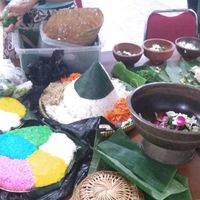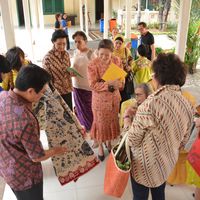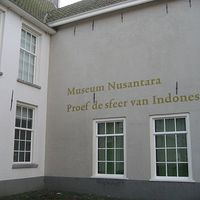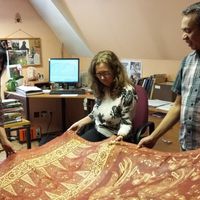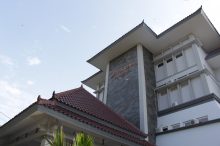
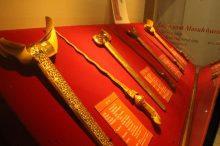
The Museum Keris Nusantara
showcases 350 ancient Keris (a traditional Indonesian dagger), all of which were donated by a number of collectors as well as the community of
Keris. Beside the
Keris, this museum also displays
Tombak (spears),
Pedang (sword),
Badik (traditional Knives from South Sulawesi) from all areas from Indonesia and part of Southeast Asia.
The Museum Keris Nusantara was inaugurated by the seventh President of Indonesia, Joko Widodo on
9 August 2017. This followed the
recognition of Indonesian Keris by UNESCO as part of the intangible cultural heritage of humanity.
The museum is located in the centre of Solo (Surakarta), at Jl. Bhayangkara No. 2
nd, Sriwedari, Solo, and Central of Java. The building of Museum Keris Nusantara adopts the
architectural style of Sukuh temples and is packed with contemporary style. It has fourth floors.
Each floor presents deep information about Keris.
In the
Wedharing Wacana floor, there are pictures of traditional weapons around the world. It also shows various types of
pamor keris, and
visitors can watch the process of keris making in the audio-visual room.
The
Purwaning Wacana floor describes the
development of keris in the modern era and visitors can also read the historical records through the manuscripts or books in the Museum Keris Nusantara
library.
Within the
Cipta Adiluhung floor, the
keris making process and how to correctly open the
keris from its
warangka (the
sheath of
keris) are presented. Furthermore, visitors can see
how to properly wear keris in Java clothes.
Finally, the
Esthing Lampah floor, enables visitors to
enjoy the work of ancestors who witnessed the progress of technology and culture of Indonesian in the past.
Permanent collections:
The
Keris presented at Museum Keris Nusantara come from the Segaluh (669-1482), Kahuripan (1019-1045), Kediri (1045-1221), Singhasari (1222-1292), Majapahit (1293-1500), Mataram Islam (1588-1651), Kartasura (1680-1745), Surakarta (1745-now) and Jogjakarta (1755-now) periods. At this time the oldest
Keris in the collection originates from the Galuh Kingdom era, estimated to be from the 7th century.
View all Asia-Europe Museum Network (ASEMUS) members in Indonesia

 The Museum Keris Nusantara showcases 350 ancient Keris (a traditional Indonesian dagger), all of which were donated by a number of collectors as well as the community of Keris. Beside the Keris, this museum also displays Tombak (spears), Pedang (sword), Badik (traditional Knives from South Sulawesi) from all areas from Indonesia and part of Southeast Asia.
The Museum Keris Nusantara was inaugurated by the seventh President of Indonesia, Joko Widodo on 9 August 2017. This followed the recognition of Indonesian Keris by UNESCO as part of the intangible cultural heritage of humanity.
The museum is located in the centre of Solo (Surakarta), at Jl. Bhayangkara No. 2nd, Sriwedari, Solo, and Central of Java. The building of Museum Keris Nusantara adopts the architectural style of Sukuh temples and is packed with contemporary style. It has fourth floors. Each floor presents deep information about Keris.
In the Wedharing Wacana floor, there are pictures of traditional weapons around the world. It also shows various types of pamor keris, and visitors can watch the process of keris making in the audio-visual room.
The Purwaning Wacana floor describes the development of keris in the modern era and visitors can also read the historical records through the manuscripts or books in the Museum Keris Nusantara library.
Within the Cipta Adiluhung floor, the keris making process and how to correctly open the keris from its warangka (the sheath of keris) are presented. Furthermore, visitors can see how to properly wear keris in Java clothes.
Finally, the Esthing Lampah floor, enables visitors to enjoy the work of ancestors who witnessed the progress of technology and culture of Indonesian in the past.
Permanent collections:
The Keris presented at Museum Keris Nusantara come from the Segaluh (669-1482), Kahuripan (1019-1045), Kediri (1045-1221), Singhasari (1222-1292), Majapahit (1293-1500), Mataram Islam (1588-1651), Kartasura (1680-1745), Surakarta (1745-now) and Jogjakarta (1755-now) periods. At this time the oldest Keris in the collection originates from the Galuh Kingdom era, estimated to be from the 7th century.
The Museum Keris Nusantara showcases 350 ancient Keris (a traditional Indonesian dagger), all of which were donated by a number of collectors as well as the community of Keris. Beside the Keris, this museum also displays Tombak (spears), Pedang (sword), Badik (traditional Knives from South Sulawesi) from all areas from Indonesia and part of Southeast Asia.
The Museum Keris Nusantara was inaugurated by the seventh President of Indonesia, Joko Widodo on 9 August 2017. This followed the recognition of Indonesian Keris by UNESCO as part of the intangible cultural heritage of humanity.
The museum is located in the centre of Solo (Surakarta), at Jl. Bhayangkara No. 2nd, Sriwedari, Solo, and Central of Java. The building of Museum Keris Nusantara adopts the architectural style of Sukuh temples and is packed with contemporary style. It has fourth floors. Each floor presents deep information about Keris.
In the Wedharing Wacana floor, there are pictures of traditional weapons around the world. It also shows various types of pamor keris, and visitors can watch the process of keris making in the audio-visual room.
The Purwaning Wacana floor describes the development of keris in the modern era and visitors can also read the historical records through the manuscripts or books in the Museum Keris Nusantara library.
Within the Cipta Adiluhung floor, the keris making process and how to correctly open the keris from its warangka (the sheath of keris) are presented. Furthermore, visitors can see how to properly wear keris in Java clothes.
Finally, the Esthing Lampah floor, enables visitors to enjoy the work of ancestors who witnessed the progress of technology and culture of Indonesian in the past.
Permanent collections:
The Keris presented at Museum Keris Nusantara come from the Segaluh (669-1482), Kahuripan (1019-1045), Kediri (1045-1221), Singhasari (1222-1292), Majapahit (1293-1500), Mataram Islam (1588-1651), Kartasura (1680-1745), Surakarta (1745-now) and Jogjakarta (1755-now) periods. At this time the oldest Keris in the collection originates from the Galuh Kingdom era, estimated to be from the 7th century.

